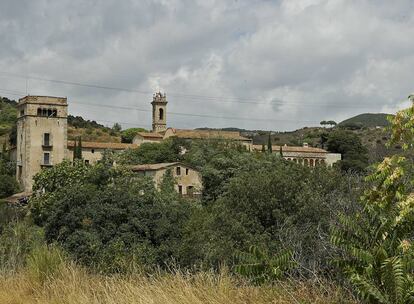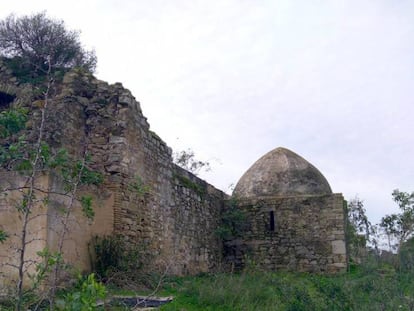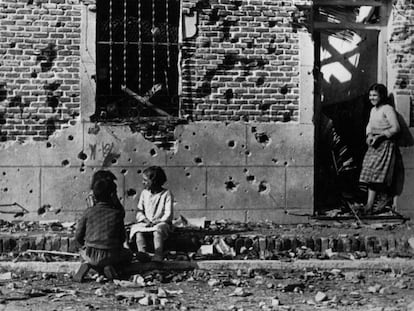Future of historic Catalan monastery that Columbus visited in limbo
Local authorities hope to save beautiful Sant Jeroni de la Murtra site but negotiations are stalled

A site with splendid surroundings. In the heart of Catalonia¡¯s Sierra de la Marina, and a stone¡¯s throw from Barcelona. Earlier this summer, an advertisement of this tenor was promoting the sale of the monastery of Sant Jeroni de la Murtra, a little-known Gothic jewel?in the city of Badalona.

Founded in 1416 by Barcelona merchant Bertran Nicolau, the monastery was frequented by the Catholic Kings Isabella I and Ferdinand II, whose marriage in 1469 resulted in the unification of Spain, and who financed many of the property¡¯s buildings. It was also a place of rest for Christopher Columbus on his return from his first trip to America. Sculptures and portraits displayed in the monastery commemorate all of these historic figures.
Renovation?work at the monastery could cost around €6 million
The listing for the property was posted by a Barcelona real estate agent, and it was short-lived. Within a few hours, word had spread rapidly and Badalona¡¯s town hall intervened. In a statement to EL PA?S, the city's urban development chief Oriol Llad¨® said: ¡°We¡¯re still uncertain about the exact manner ¨C whether by purchase, exchange or another system, but we want to secure control of the monastery and ensure that a standard is met for its maintenance ¨C comparable to that of other sites with similar cultural heritage, like the Sant Pere de Rodes [another monastery in Catalonia].¡±
The councilman notes that he has already met twice this year with the majority owner of the property, Francesca G¨¹ell ¨C daughter of Eusebi G¨¹ell, a famous entrepreneur and patron of Spanish architect Antoni Gaud¨ª.

The property was declared a historic monument in 1974, and the Catalonian government recognized it as a heritage site in 2014, giving it maximum legal protection. In other words, the economic use of the place is limited, and the only area where building is permitted is around the old inn and summer houses, which were built in the 19th century and are now closed to the public.
From the monastery¡¯s heights, you can see the sea and the forest of the Sierra de la Marina, in addition to a well-tended orchard. It is a privileged location in which 10 people live. With the assistance of 50 volunteers from the association Amics de Sant Jeroni de la Murtru, they are charged with looking after the property.
Silence and serenity define the ambience of this massive estate, a place of retreat sought out by more than 200 people who annually spend a few days in one of its 8 cells on retreat, an activity that began in 1971.

¡°I don¡¯t know what the best option is, but a consensus among all parties needs to be sought,¡± says Jaume Aymar, priest of the monastery¡¯s church, when asked about the property¡¯s future. He believes that regardless of who eventually owns it, the current uses should be maintained.
Llad¨® recognizes that the issue is complex: ¡°We want to push ahead with a management plan to outline the current conditions of everything.¡± He says that the monastery¡¯s main buildings ¨C?the Gothic cloister, the defense tower and the chapel ¨C?are all in good condition. In fact, the cloister underwent a full program of restoration just seven years ago. ¡°The buildings that are in bad shape are the old inn and the summer houses, which, practically speaking, form the only area where one could build ¨C as long as the new development is something small, like a rental country house or a small hotel. But in order to do any of that, we¡¯ll have first to reach an agreement between all parties.¡±
A proposal has been drafted, but Llad¨® stresses that this will not be looked at again until September.
An estimated price has not been given for the property but the figure of €6 million has cropped up. The real estate agency that originally advertised it did not list a price.

Money for preserving historic monuments has been something of an issue in recent years for Spain. Many rural areas in the country have been largely abandoned, leading to a loss in revenue that has made it difficult for small communities to finance their own preservation work. The problem is compounded by the fact that state funding for restorations has also decreased since the collapse of Spain¡¯s property market in 2008 ¨C with spending on historic sites falling by 44% between 2008 and 2014, according to one figure.
For Badalona¡¯s city hall, what matters now is ensuring the future of a property that, in the 1990s, came close to becoming a golf course. Urban administrators certainly hope it does not meet that fate this time around.
English version by Henry Hahn.
Tu suscripci¨®n se est¨¢ usando en otro dispositivo
?Quieres a?adir otro usuario a tu suscripci¨®n?
Si contin¨²as leyendo en este dispositivo, no se podr¨¢ leer en el otro.
FlechaTu suscripci¨®n se est¨¢ usando en otro dispositivo y solo puedes acceder a EL PA?S desde un dispositivo a la vez.
Si quieres compartir tu cuenta, cambia tu suscripci¨®n a la modalidad Premium, as¨ª podr¨¢s a?adir otro usuario. Cada uno acceder¨¢ con su propia cuenta de email, lo que os permitir¨¢ personalizar vuestra experiencia en EL PA?S.
En el caso de no saber qui¨¦n est¨¢ usando tu cuenta, te recomendamos cambiar tu contrase?a aqu¨ª.
Si decides continuar compartiendo tu cuenta, este mensaje se mostrar¨¢ en tu dispositivo y en el de la otra persona que est¨¢ usando tu cuenta de forma indefinida, afectando a tu experiencia de lectura. Puedes consultar aqu¨ª los t¨¦rminos y condiciones de la suscripci¨®n digital.










































